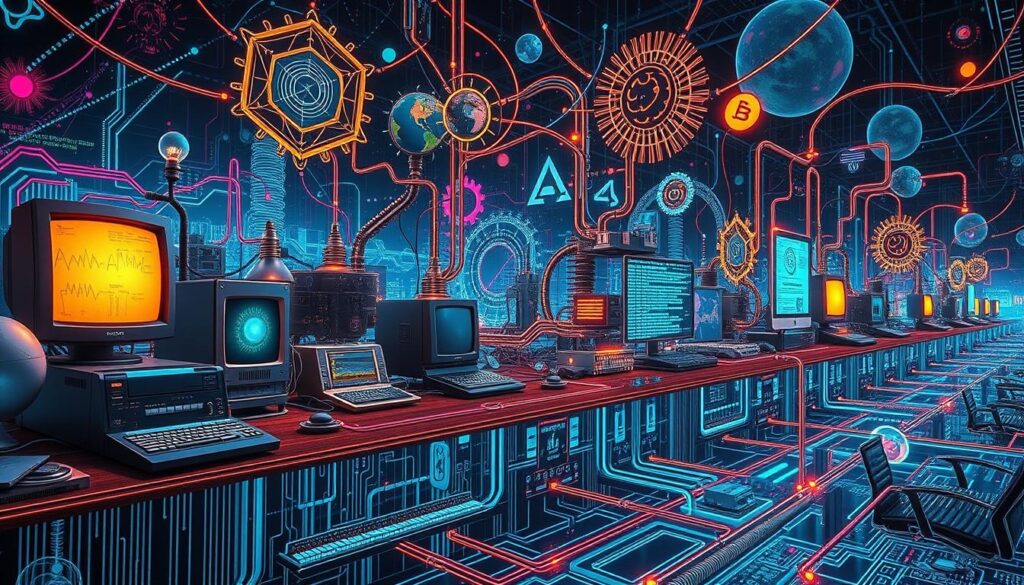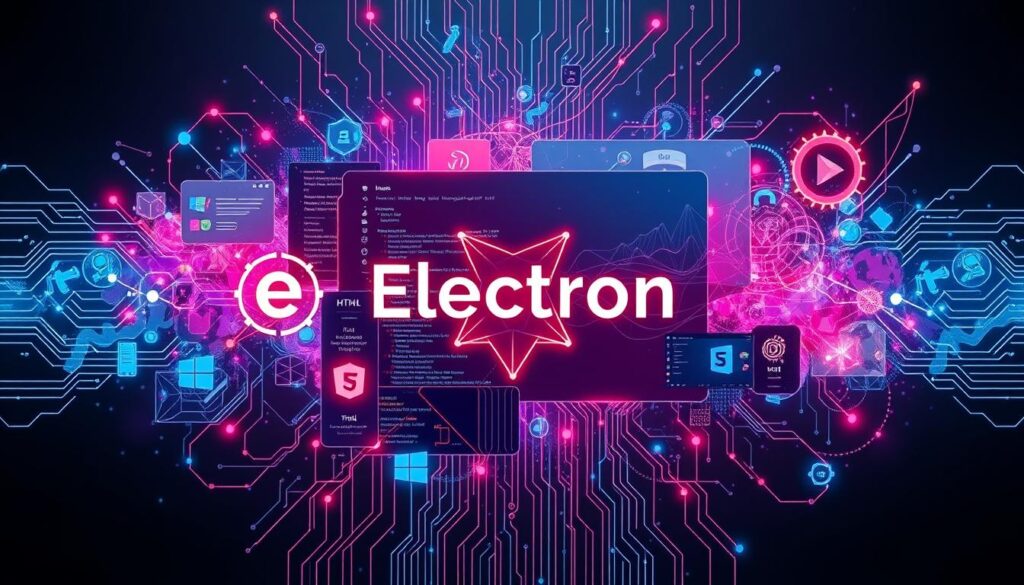
Did you know Electron is behind big names like Visual Studio Code, Slack, and WhatsApp desktop? It’s an open-source framework that’s become a big deal. It lets developers make desktop apps that work on Windows, macOS, and Linux.
What is Electron? Electron uses web tech like HTML, CSS, and JavaScript. This means we can make apps that look and act like they were made for the desktop. And the best part? An app can run on many platforms with just a few tweaks.
It started at GitHub and combines Chromium and Node.js. This mix gives us a strong rendering engine and server-side JavaScript. It makes apps feel like they’re part of the desktop, improving both user and developer experience.
Key Takeaways
- Electron is an open-source framework that supports developing cross-platform desktop applications using web technologies.
- Originating from GitHub, it integrates Chromium and Node.js for robust performance.
- Electron enables applications to be written once and deployed on Windows, macOS, and Linux without significant modifications.
- Known for powering popular apps like Visual Studio Code, Slack, and WhatsApp Desktop.
- Provides a vibrant ecosystem of plugins and extensions to enhance and extend application functionality.
Understanding Electron and Its Origins
The history of Electron started in the late 19th century. Scientists were curious about cathode rays. J.J. Thomson discovered the electron in 1897, starting a new era in science.
Thomson found that an electron is much lighter than atoms. He also figured out how fast it moves. This was a big step forward.
Thomson’s work showed that electrons are very fast. Millikan’s oil-drop experiment in 1909 confirmed their charge. This proved that electricity is made of tiny particles.
Wilhelm Wien found that electrons are different from other particles. This led to more discoveries. Thomson found stable isotopes in 1913, and Aston made the mass spectrograph in 1919.
These tools helped us understand elements better. Today, we use this knowledge to make new technologies. GitHub’s Atom Shell, now known as Electron, changed how apps are made.
| Discoveries | Significance |
|---|---|
| J.J. Thomson’s Electron Discovery (1897) | Revealed the electron’s mass and velocity |
| Millikan’s Oil-Drop Experiment (1909) | Determined the electron charge |
| Wilhelm Wien’s Findings | Highlighted mass-to-charge ratio differences |
| Thomson’s Neon Gas Experiments (1913) | Discovered stable isotopes |
| Aston’s Mass Spectrograph (1919) | Analyzed elements and isotopes |
The history of Electron is filled with important discoveries. These findings have helped us make new technologies. They have pushed the limits of physics and tech.
What is Electron
Software development has seen a big change with Electron. It’s a framework that uses web technologies like HTML, CSS, and JavaScript. This makes it easy to build apps that work on many platforms.
Electron is known for making apps work on different operating systems. This includes Windows, macOS, and Linux. It means one code can work on all, saving time and effort. It uses the Chromium engine for rendering and Node.js for backend tasks.
Electron combines web tech with native apps, making them better for users. It makes apps easier to develop and adds features like crash reports and updates. It’s a top choice for many developers.
Electron is special because it uses web development ideas for desktop apps. Its ability to work on many platforms shows its value and usefulness in tech.
The Power of Electron for Software Development
Electron has changed the game for desktop apps. It combines Chromium and Node.js for a top-notch development experience. This lets apps run smoothly on Windows, macOS, and Linux.
Electron makes it easy to use web tech for desktop apps. This means you don’t need to know a lot about native development. It speeds up your work and lets you use what you already know.
Benefits for Developers:
- Seamless Chromium and Node.js integration
- Cross-platform compatibility (Windows, macOS, Linux)
- Access to a rich library of plugins, extensions, and UI components
- Engaged community support through Discord and GitHub
Apps like Visual Studio Code, Slack, and Discord show Electron’s power. They handle tough tasks well. This proves Electron is great for making apps that are full-featured, easy to keep up, and safe.
| Benefit | Description |
|---|---|
| Cross-Platform Development | Create applications for Windows, macOS, and Linux |
| Chromium Integration | Powerful rendering engine for enhanced performance |
| Node.js Runtime | Robust backend environment |
| Community Support | Resources like Discord server and GitHub issue tracker |
Electron’s world keeps growing. Tools like Electron Fiddle help you try out new things. There’s also a big library of tutorials to help you learn and publish apps.
But, there are downsides. Apps might be bigger and use more memory. So, you need to make sure they run well.
Electron’s mix of Chromium and Node.js is a big plus. It makes developing apps easier and offers lots of help. This makes it a top pick for making desktop apps.
Diving into Electron Architecture
Learning about Electron architecture can make your desktop apps work better. At the heart is Electron’s multiprocess architecture. It has two main processes, “main” and “renderer,” working together. This setup keeps tasks separate, making apps more stable and secure.
The main process handles BrowserWindow instances and app events. On the other hand, the renderer process shows the user interface. It uses Chromium to run each tab separately, just like a browser. This helps keep the app running smoothly and prevents any one process from slowing others down.
Electron uses named pipes for interprocess communication (IPC). This lets the main and renderer processes talk to each other easily. However, using synchronous IPC calls can slow things down, especially if the renderer needs to access main process functions. So, it’s best to move CPU-heavy tasks to the renderer process to avoid slowing down the main process.
Electron is great for apps of all sizes. Simple apps like messengers or streaming services work well with Electron. More complex apps, like music streaming with local cache, can grow easily. Even complex apps, like batch image processors, do well with Electron’s process management. For more on advanced Electron.js architecture, check out this detailed article.
| Electron Feature | Description |
|---|---|
| Main Process | Manages BrowserWindow instances and handles application events. |
| Renderer Process | Displays the user interface and runs each tab separately with Chromium for stability. |
| IPC (Interprocess Communication) | Facilitates both asynchronous and synchronous communication between processes using named pipes. |
| Electron Helper | Assists in GPU tasks and multiple renderer processes operations. |
| Node Integration | Disabled by default from Electron version 5 to enhance security. |
| Remote Module | Allows access to main process functionalities in the renderer, though synchronous calls may affect performance. |
Conclusion
The electron has been key in understanding atoms and complex phenomena. J.J. Thomson found that cathode rays could be deflected by fields, showing the electron’s existence. Robert Millikan’s work on the electron’s charge helped us learn about its mass, changing particle physics.
Looking back, we see how electron studies have evolved. Marie and Pierre Curie’s work on polonium and radium showed how subatomic particles behave. Ernest Rutherford’s gold foil experiment changed our view of atoms, showing how electrons move.
The future of electron technology is bright. The Electron framework is making web and desktop apps more alike. The electron community’s support and updates are crucial. Electrons play a big role in science and technology, shaping our future.
FAQ
What is Electron?
Electron is an open-source framework that changes how we make desktop apps. It uses web tech like HTML, CSS, and JavaScript. This lets apps work well on Windows, macOS, and Linux.
What is the history of Electron?
Electron started as ‘Atom Shell’ by GitHub for the Atom code editor. It grew into a framework for making desktop apps. Now, it’s known as Electron.
What makes Electron unique?
Electron is special because it mixes Chromium’s rendering with Node.js’s JavaScript. This lets developers use web tech to make top-notch desktop apps. It connects the web and desktop worlds.
How does Electron ensure cross-platform compatibility?
Electron uses Chromium for rendering and Node.js for backend tasks. This makes apps work the same on Windows, macOS, and Linux. It makes app development easier and better.
What are the benefits of using Electron for developers?
Electron gives developers a strong rendering engine and backend thanks to Chromium and Node.js. This boosts app performance and reliability. It’s why apps like Visual Studio Code and Slack use it.
How does Electron architecture work?
Electron’s design has a main process for app management and a renderer for the webpage. This setup improves app speed and safety. It makes apps run smoothly.
What are some popular applications built with Electron?
Apps like Visual Studio Code, Slack, and Atom use Electron. They show how well Electron handles complex tasks. And how it keeps apps running well on different platforms.
How does Electron integrate web technologies into desktop applications?
Electron mixes web tech like HTML, CSS, and JavaScript with Chromium and Node.js. This creates a single coding method for desktop apps. It makes app development easier and more effective.
Future App Studios is an award-winning software development & outsourcing company. Our team of experts is ready to craft the solution your company needs.










